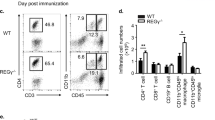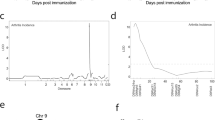Abstract
Notch receptors are processed by γ-secretase acting in synergy with T cell receptor signaling to sustain peripheral T cell activation. Activated CD4+ T cells differentiate into T helper type 1 (TH1) or TH2 subsets. Molecular cues directing TH1 differentiation include expression of the TH1-specific transcription factor T-bet, encoded by Tbx21. However, the regulation of Tbx21 remains incompletely defined. Here we report that Notch1 can directly regulate Tbx21 through complexes formed on the Tbx21 promoter. In vitro, γ-secretase inhibitors extinguished expression of Notch, interferon-γ and Tbx21 in TH1-polarized CD4+ cells, whereas ectopic expression of activated Notch1 restored Tbx21 transcription. In vivo, administration of γ-secretase inhibitors substantially impeded TH1-mediated disease progression in the mouse experimental autoimmune encephalomyelitis model of multiple sclerosis. Thus, using γ-secretase inhibitors to modulate Notch signaling may prove beneficial in treating TH1-mediated autoimmunity.
This is a preview of subscription content, access via your institution
Access options
Subscribe to this journal
Receive 12 print issues and online access
$209.00 per year
only $17.42 per issue
Buy this article
- Purchase on Springer Link
- Instant access to full article PDF
Prices may be subject to local taxes which are calculated during checkout





Similar content being viewed by others
Change history
06 July 2018
This article was initially published with an incorrect DOI. A new DOI has been assigned and registered at Crossref, and has been corrected in the article.
References
Baron, M. An overview of the Notch signaling pathway. Semin. Cell Dev. Biol. 14, 113–119 (2003).
De Strooper, B. et al. A presenilin-1-dependent γ-secretase-like protease mediates release of Notch intracellular domain. Nature 398, 518–522 (1999).
Struhl, G. & Adachi, A. Nuclear access and action of notch in vivo . Cell 93, 649–660 (1998).
Kopan, R. & Ilagan, M.X. γ-secretase: proteasome of the membrane? Nat. Rev. Mol. Cell Biol. 5, 499–504 (2004).
Radtke, F., Wilson, A., Mancini, S.J.C. & MacDonald, R. Notch regulation of lymphocyte development and function. Nat. Immunol. 5, 247–253 (2004).
Adler, S.H. et al. Notch signaling augments T cell responsiveness by enhancing CD25 expression. J. Immunol. 171, 2896–2903 (2003).
Palaga, T., Miele, L., Golde, T.E. & Osborne, B.A. TCR-mediated Notch signaling regulates proliferation and IFN-γ production in peripheral T cells. J. Immunol. 171, 3019–3024 (2003).
Murphy, K.M. & Reiner, S.L. The lineage decisions of helper T cells. Nat. Rev. Immunol. 2, 933–944 (2002).
Maekawa, Y. et al. Delta1-Notch3 interactions bias the functional differentiation of activated CD4+ T cells. Immunity 19, 549–559 (2003).
Amsen, D. et al. Instruction of distinct CD4 T helper cell fates by different notch ligands on antigen-presenting cells. Cell 117, 515–526 (2004).
Szabo, S. et al. A novel transcription factor, t-bet, directs Th1 lineage commitment. Cell 100, 655–669 (2000).
Szabo, S. et al. Distinct effects of T-bet in Th1 lineage commitment and IFN-γ production in CD4 and CD8 T cells. Science 295, 338–342 (2002).
Afkarian, M. et al. T-bet is a STAT1-induced regulator of IL-12R expression in naïve CD4+ T cells. Nat. Immunol. 3, 549–557 (2001).
Mullen, A.C. et al. Role of T-bet in commitment of TH1 cells before IL-12-dependent selection. Science 292, 1907–1910 (2001).
Gavrilescu, L.C., Butcher, B.A., Del Rio, L., Taylor, G.A. & Denkers, E.Y. STAT1 is essential for antimicrobial effector function but dispensable for γ interferon production during Toxoplasma gondii infection. Infect. Immun. 72, 1257–1264 (2004).
Lovett-Racke, A.E. et al. Silencing t-bet defines a critical role in the differentiation of autoreactive T lymphocytes. Immunity 21, 719–731 (2004).
Bettelli, E. et al. Loss of t-bet but not STAT1 prevents the development of experimental autoimmune encephalomyelitis. J. Exp. Med. 200, 79–87 (2004).
Dal Canto, M.C., Melvold, R.V., Kim, B.S. & Miller, S.D. Two models of multiple sclerosis: experimental allergic encephalomyelitis (EAE) and Theiler's murine encephalomyelitis virus (TMEV) infection. A pathological and immunological comparison. Microsc. Res. Tech. 32, 215–229 (1995).
Szabo, S.J., Dighe, A.S., Gubler, U. & Murphy, K.M. Regulation of the interleukin (IL)-12R beta 2 subunit expression in developing T helper 1 (Th1) and Th2 cells. J. Exp. Med. 185, 817–824 (1997).
Cheng, P. et al. Notch-1 regulates NF-κB activity in hemopoietic progenitor cells. J. Immunol. 167, 4458–4467 (2001).
Tacchini-Cottier, F., Allenbach, C., Otten, L.A. & Radtke, F. Notch1 expression is not required for CD4+ T helper differentiation. Eur. J. Immunol. 34, 1588–1596 (2004).
Bird, J.J. et al. Helper T cell differentiation is controlled by the cell cycle. Immunity 9, 229–237 (1998).
Agarwal, S. & Rao, A. Modulation of chromatin structure regulates cytokine gene expression during T cell differentiation. Immunity 9, 765–775 (1998).
Mullen, A.C. et al. Cell cycle controlling the silencing and functioning of mammalian activators. Curr. Biol. 11, 1695–1699 (2001).
Seki, N. et al. IL-4-induced GATA-3 expression is a time-restricted instruction switch for Th2 cell differentiation. J. Immunol. 172, 6158–6166 (2004).
Shuai, K. & Liu, B. Regulation of JAK-STAT signaling in the immune system. Nat. Rev. Immunol. 3, 900–911 (2003).
Sekimoto, T., Nakajima, K., Tachibana, T., Hirano, T. & Yoneda, Y. Interferon-γ-dependent nuclear import of Stat1 is mediated by the GTPase activity of Ran/TC4. J. Biol. Chem. 271, 31017–31020 (1996).
Thierfelder, W.E. et al. Requirement for Stat4 in interleukin-12-mediated responses of natural killer and T cells. Nature 382, 171–174 (1996).
Kaplan, M.H., Sun, Y.L., Hoey, T. & Grusby, M.J. Impaired IL-12 responses and enhanced development of Th2 cells in Stat4-deficient mice. Nature 382, 174–177 (1996).
Takeda, K. et al. Essential role of Stat6 in IL-4 signaling. Nature 380, 627–630 (1996).
Deftos, M.L., He, Y.-W., Ojala, E.W. & Bevan, M.J. Correlating Notch signaling with thymocyte maturation. Immunity 9, 777–786 (1998).
Lammich, S. et al. Presenilin-dependent intramembrane proteolysis of CD44 leads to the liberation of its intracellular domain and the secretion of an Aβ-like peptide. J. Biol. Chem. 277, 44754–44759 (2002).
Zhou, S. & Hayward, D. Nuclear localization of CBF1 is regulated by interactions with the SMRT corepressor complex. Mol. Cell. Biol. 21, 6222–6232 (2001).
Nam, Y., Weng, A.P., Aster, J.C. & Blacklow, S.C. Structural requirements for assembly of the CSL-intracellular Notch1-Mastermind-like1 transcriptional activation complex. J. Biol. Chem. 278, 21232–21239 (2003).
Weinmann, A.S. Novel ChIP-based strategies to uncover transcription factor target genes in the immune system. Nat. Rev. Immunol. 4, 381–386 (2004).
Barth, H. et al. Analysis of immunoregulatory T-helper cell subsets in patients with multiple sclerosis: relapsing-progressive course correlates with enhanced Th1, relapsing-remitting course with enhanced Th0 reactivity. J. Neuroimmunol. 133, 175–183 (2002).
Parronchi, P. et al. Type 1 T-helper cell predominance and interleukin-12 expression in the gut of patients with Crohn's disease. Am. J. Pathol. 150, 823–832 (1997).
Hartung, A.D. et al. Th-2 mediated atopic disease protection in Th1-mediated rheumatoid arthritis. Clin. Exp. Rheumatol. 21, 481–484 (2003).
Larche, M., Robinson, D.S. & Kay, A.B. The role of T lymphocytes in the pathogenesis of asthma. J. Allergy Clin. Immunol. 111, 450–463 (2003).
Tanigaki, K. et al. Regulation of αβ/γδ T cell lineage commitment and peripheral T cell responses by Notch/RBP-J signaling. Immunity 20, 611–622 (2004).
Zhang, Z. et al. Presenilins are required for γ-secretase cleavage of β-APP and transmembrane cleavage of Notch-1. Nat. Cell Biol. 2, 463–465 (2000).
Berezovska, O. et al. Notch1 and amyloid precursor protein are competitive substrates for presenilin1-dependent gamma-secretase cleavage. J. Biol. Chem. 276, 30018–30023 (2001).
Kipnis, A., Basaraba, R.J., Turner, J. & Orme, I.M. Increased neutrophil influx but no impairment of protective immunity to tuberclosis in mice lacking the CD44 molecule. J. Leukoc. Biol. 74, 992–997 (2003).
Wong, K.K. et al. Notch ligation by Delta1 inhibits peripheral immune responses to transplantation antigens by a CD8+ cell-dependent mechanism. J. Clin. Invest. 112, 1741–1750 (2003).
Mizutani, T., Taniguchi, Y., Aoki, T., Hashimoto, N. & Honjo, T. Conservation of the biochemical mechanisms of signal transduction among mammalian Notch family members. Proc. Natl. Acad. Sci. USA 98, 9026–9031 (2001).
Siemers, E. et al. Effect of LY450139, a functional γ-secretase inhibitor, on plasma and cerebrospinal fluid concentrations of A-β and cognitive functioning in patients with mild to moderate Alzheimer's disease. Neurology 62, A174 Abstract S17.001 (2004).
Lanz, T.A., Hosley, J.D., Adams, W.J. & Merchant, K.M. Studies of Aβ pharmacodynamics in the brain, cerebrospinal fluid, and plasma in young (plaque-free) Tg2576 mice using the gamma-secretase inhibitor N2-[(2S)-2-(3,5-difluorophenyl)-2-hydroxyethanoyl]-N1-[(7S)-5-methyl-6-oxo-6,7-dihydro-5H-dibenzo[b,d]azepin-7-yl]-L-alaninamide (LY-411575). J. Pharmacol. Exp. Ther. 309, 49–55 (2004).
Anderson, G., Pongracz, J., Parnell, S. & Jenkinson, E.J. Notch ligand-bearing thymic epithelial cells initiate and sustain Notch signaling in thymocytes independently of T cell receptor signaling. Eur. J. Immunol. 31, 3349–3354 (2001).
Acknowledgements
The authors thank members of the Osborne Lab for discussions and R.A. Goldsby for critical reading of the manuscript. Supported by a Ruth L. Kirschstein National Research Service Award (L.M.M.).
Author information
Authors and Affiliations
Corresponding author
Ethics declarations
Competing interests
The authors declare no competing financial interests.
Supplementary information
Supplementary Fig. 1
GSI abrogates IFN-γ secretion but CD44 expression and its affinity for ligand is unaffected.
Supplementary Fig. 2
Retroviral infection efficiencies of CD4+ T cells are comparable in DMSO- and GSI-pretreated cells, regardless of polarizing conditions.
Supplementary Fig. 3
Putative CSL binding sites are located in the murine Tbx21 promoter region.
Supplementary Fig. 4
Oral GSI treatment during EAE induction with PLP139-151 decreases ex vivo proliferation and IFN-γ production upon restimulation with peptide.
Rights and permissions
About this article
Cite this article
Minter, L., Turley, D., Das, P. et al. Inhibitors of γ-secretase block in vivo and in vitro T helper type 1 polarization by preventing Notch upregulation of Tbx21. Nat Immunol 6, 680–688 (2005). https://doi.org/10.1038/ni1209x
Received:
Accepted:
Published:
Issue Date:
DOI: https://doi.org/10.1038/ni1209x
This article is cited by
-
The role of Notch signaling in endometrial mesenchymal stromal/stem-like cells maintenance
Communications Biology (2022)
-
Identification of NOTCH4 mutation as a response biomarker for immune checkpoint inhibitor therapy
BMC Medicine (2021)
-
Isolation of nocobactin NAs as Notch signal inhibitors from Nocardia farcinica, a possibility of invasive evolution
The Journal of Antibiotics (2021)
-
Interferon gamma inhibits the differentiation of mouse adult liver and bone marrow hematopoietic stem cells by inhibiting the activation of notch signaling
Stem Cell Research & Therapy (2019)
-
IL-17 induced NOTCH1 activation in oligodendrocyte progenitor cells enhances proliferation and inflammatory gene expression
Nature Communications (2017)



